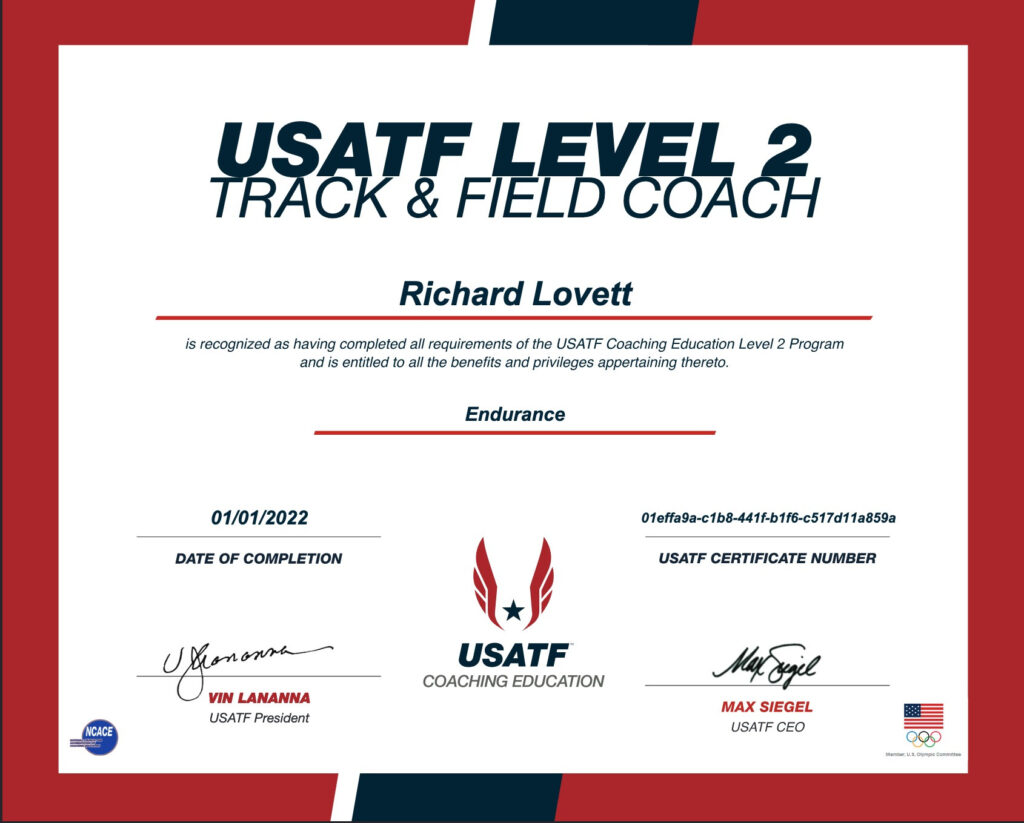
By Rick Lovett
“What I did on vacation” is something you’d think every grade school kid had to write about someday. But if I ever did, I can’t remember it. So how could I resist assigning the topic to myself?
What I did (some of it in October and November) was 60+ hours of online videos, quizzes, and very intensive Zoom, at the end of which I came away with a USATF level 2 coaching certificate in endurance running. It’s something I’d toyed with doing for years, but this was the first time, thanks to the combination of COVID and Zoom, I didn’t have to travel halfway across the country to do it. The TRL board also voted to assist with the tuition, which I very much appreciated.
Going in, I wasn’t sure what I might learn that would be useful to TRL. Most of the other participants were middle school or high school coaches, so I knew a lot of the material wouldn’t be relevant to us. But a lot was very useful, ranging from scattered tidbits to materials that reinforced things I’d previously been thinking about.
One of the most interesting tidbits is this: Want a quick-and-easy way to check your resting heart rate in the morning? Get a pulse oximeter and keep it on your nightstand. That way, you can put it on when you wake up and get an accurate reading, without unintentionally elevating your heart rate by trying to do something more complex, like activating a timer and trying to count your pulse in your neck or wrist. Do this for a few days to get your baseline, then, if your morning heart rate is elevated for two or three days in succession, take it as a sign that something is going wrong, whether its overtraining, an incipient virus (hopefully not COVID), lack of sleep, or stress from unrelated life events. Whatever the cause, this is your early warning signal that something is going wrong, and a pulse oximeter (easily obtainable online) is a great way to get it.
The course also reinforced the usefulness of short time trials, particularly at the start of a training cycle. What’s short? Anything between 8 minutes and 2 miles. That’s about the distance you can run at VO2max (also called maximum aerobic speed), and once you convert it to a per-lap pace, there’s a lot you can do with it.
To begin with, this is a great training pace for certain types of work, such as 600s and 800s run on 400m recoveries that take about as long as the preceding interval. But from it, you can calculate your 5K pace (maybe 4 sec/lap slower), your 10K pace (about 4 sec/lap slower than that), your tempo pace (2 seconds per lap slower yet), and in theory your marathon pace (maybe 6 sec/lap slower than tempo).
Not that I’d extrapolate from an 8-minute time trial to a marathon with any hope of anything other than a crude estimate, but it’s still good for setting your pace in floats, which are often run at marathon pace. And it’s even more useful for setting your easy run pace, which shouldn’t be more than 65 to 70 percent as fast.
Another thing the course reinforced is the need for sprint speed, even for marathoners. If you come to Duniway, you know that we already do some of that, with 400s, 200s and 150s. But the new focus is on shorter and faster than that.
How short? Think 30 meters. Probably less if you aren’t super-fast. Something you’ll cover in 5-6 seconds, tops.
The protocol is to warm up, then take a jog start, slowly speeding up. When you’re up to pace, sprint, all out, for about 30 meters (or 15-18 steps), then ease off and cruise to a halt, being careful not to brake too suddenly.
The zinger is that this requires significant recovery. There are a couple of protocols. One is to do two to three sets of two or three reps each, with 90 sec between repeats (walk back, don’t jog), and a whopping 8-10 minutes between sets. The other is to put 3 minutes between elements of the set and dispense with the set breaks. Then do maybe 4 reps, total.
There are caveats, starting with not beginning with too many, and being careful not to do this if the weather is cold and you are stiff. But the good news is that you can do this on an easy day, then head out for your normal run. And you only need to do it once every two weeks.
So, those are three things I learned. There are more, for which I again thank the TRL Board for its assistance. You’ll probably hear about them at Duniway if you are there and they become relevant. Part of the fun of this type of thing is that you don’t realize what you learned until you find yourself applying it.